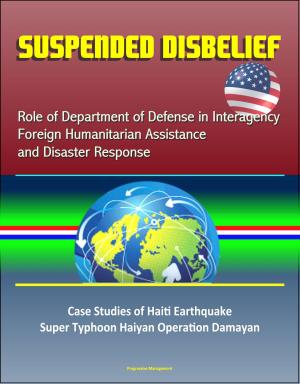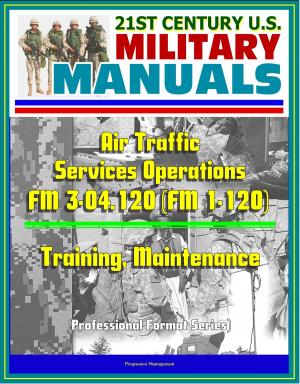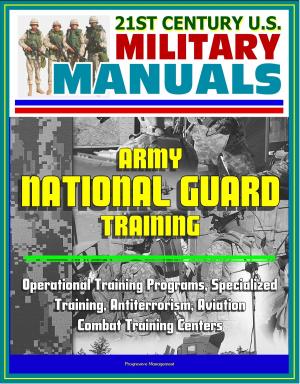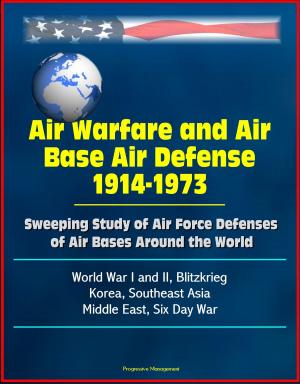Case Studies in the Development of Close Air Support (CAS) - Luftwaffe Experience, Soviet Air-Ground, Tunisian Campaign, Sicily, Italy, Battle for France, Korea, Southeast Asia, Israel, RAF, Goodwood
Nonfiction, History, Military, Aviation, World War II| Author: | Progressive Management | ISBN: | 9781311007285 |
| Publisher: | Progressive Management | Publication: | July 12, 2015 |
| Imprint: | Smashwords Edition | Language: | English |
| Author: | Progressive Management |
| ISBN: | 9781311007285 |
| Publisher: | Progressive Management |
| Publication: | July 12, 2015 |
| Imprint: | Smashwords Edition |
| Language: | English |
Professionally converted for accurate flowing-text e-book format reproduction, this unique USAF publication provides fascinating original case studies about close air support.
The introduction of airplanes to warfare led almost from the first to their application in close support of ground forces. The earliest attempts at influencing the outcome of a ground battle from the air were limited by the fragility of the craft engaged and the lack of coherent ideas on the most effective use of what was still a novelty. What began as an expedient, however, has become over nearly ten decades an essential role for air power. Taken virtually for granted by troops and aviators today, the employment of air power in this way has been controversial from the first instance in which bombs were dropped on ground combatants during the Italo-Turkish war of 1911-1912. Ground and air commanders have differed over the proper use of aviation; preferences and assumptions on doctrine have evolved in both the ground and air communities; technology has changed air systems and defensive ground weaponry; and with time different systems or techniques have developed in various military establishments for the command and control of ground and air forces operating in concert, for liaison and communications, and for delivering aerial firepower in support of land forces locked in combat with an enemy.
In December 1982, Maj. Gen. Perry McCoy Smith, then the Air Force Director of Plans, asked the Office of Air Force History to prepare a number of case-study volumes on various aspects of air warfare. Col. John A. Warden III, in the Office of the Deputy Chief of Staff for Plans and Operations, provided funds from the Air Force's Project Warrior Program. With further generous assistance of Dr. Andrew Marshall, then Director of Net Assessment in the Office of the Secretary of Defense, the Air Force History Program approached some of the foremost historians in the field of military aviation to record their assessments as a resource for planning within the Air Force and the Army for several years to come. Each author was asked to produce an original case study on a defined period or subject. The essays were to be based on all relevant published literature and on the key archival documents containing the record of how various air forces actually developed and applied their systems of close air support to ground combat. Each author was also asked to cover certain basic topics: initial doctrine, organization of forces, background and courses of the air-ground campaigns, communications systems, command and control arrangements, weaponry and technology, and the decisions and people that determined the course of action and shaped its outcome. A concluding retrospect draws generalizations from the experiences presented.
The Office of Air Force History believes that this volume will be of substantial value not only to the U.S. Air Force and the U.S. Army, but should also appeal to a wider audience interested in all aspects of military history and contribute to informing the American public about the characteristics and the use of air power in all of its aspects.
Chapter 1 - Developments to 1939 * Lee Kennett * Chapter 2 - The Luftwaffe Experience, 1939-1941 * Williamson Murray * Chapter 3 - Soviet Air-Ground Coordination, 1941-1945 * Kenneth R. Whiting * Chapter 4 - The Tunisian Campaign, 1942-1943 * David Syrett * Chapter 5 - Allied Cooperation in Sicily and Italy, 1943-1945 * Alan F. Wilt * Chapter 6 - The Battle for France, 1944 * Will A. Jacobs * Chapter 7 - American Experience in the Southwest Pacific * Joe Gray Taylor * Chapter 8 - Korea, 1950-1953 * Allan R. Millett * Chapter 9 - Southeast Asia * John J. Sbrega * Chapter 10 - The Israeli Experience * Brereton Greenhous * Chapter 11 - A Retrospect on Close Air Support * I. B. Holley, Jr.
Professionally converted for accurate flowing-text e-book format reproduction, this unique USAF publication provides fascinating original case studies about close air support.
The introduction of airplanes to warfare led almost from the first to their application in close support of ground forces. The earliest attempts at influencing the outcome of a ground battle from the air were limited by the fragility of the craft engaged and the lack of coherent ideas on the most effective use of what was still a novelty. What began as an expedient, however, has become over nearly ten decades an essential role for air power. Taken virtually for granted by troops and aviators today, the employment of air power in this way has been controversial from the first instance in which bombs were dropped on ground combatants during the Italo-Turkish war of 1911-1912. Ground and air commanders have differed over the proper use of aviation; preferences and assumptions on doctrine have evolved in both the ground and air communities; technology has changed air systems and defensive ground weaponry; and with time different systems or techniques have developed in various military establishments for the command and control of ground and air forces operating in concert, for liaison and communications, and for delivering aerial firepower in support of land forces locked in combat with an enemy.
In December 1982, Maj. Gen. Perry McCoy Smith, then the Air Force Director of Plans, asked the Office of Air Force History to prepare a number of case-study volumes on various aspects of air warfare. Col. John A. Warden III, in the Office of the Deputy Chief of Staff for Plans and Operations, provided funds from the Air Force's Project Warrior Program. With further generous assistance of Dr. Andrew Marshall, then Director of Net Assessment in the Office of the Secretary of Defense, the Air Force History Program approached some of the foremost historians in the field of military aviation to record their assessments as a resource for planning within the Air Force and the Army for several years to come. Each author was asked to produce an original case study on a defined period or subject. The essays were to be based on all relevant published literature and on the key archival documents containing the record of how various air forces actually developed and applied their systems of close air support to ground combat. Each author was also asked to cover certain basic topics: initial doctrine, organization of forces, background and courses of the air-ground campaigns, communications systems, command and control arrangements, weaponry and technology, and the decisions and people that determined the course of action and shaped its outcome. A concluding retrospect draws generalizations from the experiences presented.
The Office of Air Force History believes that this volume will be of substantial value not only to the U.S. Air Force and the U.S. Army, but should also appeal to a wider audience interested in all aspects of military history and contribute to informing the American public about the characteristics and the use of air power in all of its aspects.
Chapter 1 - Developments to 1939 * Lee Kennett * Chapter 2 - The Luftwaffe Experience, 1939-1941 * Williamson Murray * Chapter 3 - Soviet Air-Ground Coordination, 1941-1945 * Kenneth R. Whiting * Chapter 4 - The Tunisian Campaign, 1942-1943 * David Syrett * Chapter 5 - Allied Cooperation in Sicily and Italy, 1943-1945 * Alan F. Wilt * Chapter 6 - The Battle for France, 1944 * Will A. Jacobs * Chapter 7 - American Experience in the Southwest Pacific * Joe Gray Taylor * Chapter 8 - Korea, 1950-1953 * Allan R. Millett * Chapter 9 - Southeast Asia * John J. Sbrega * Chapter 10 - The Israeli Experience * Brereton Greenhous * Chapter 11 - A Retrospect on Close Air Support * I. B. Holley, Jr.















